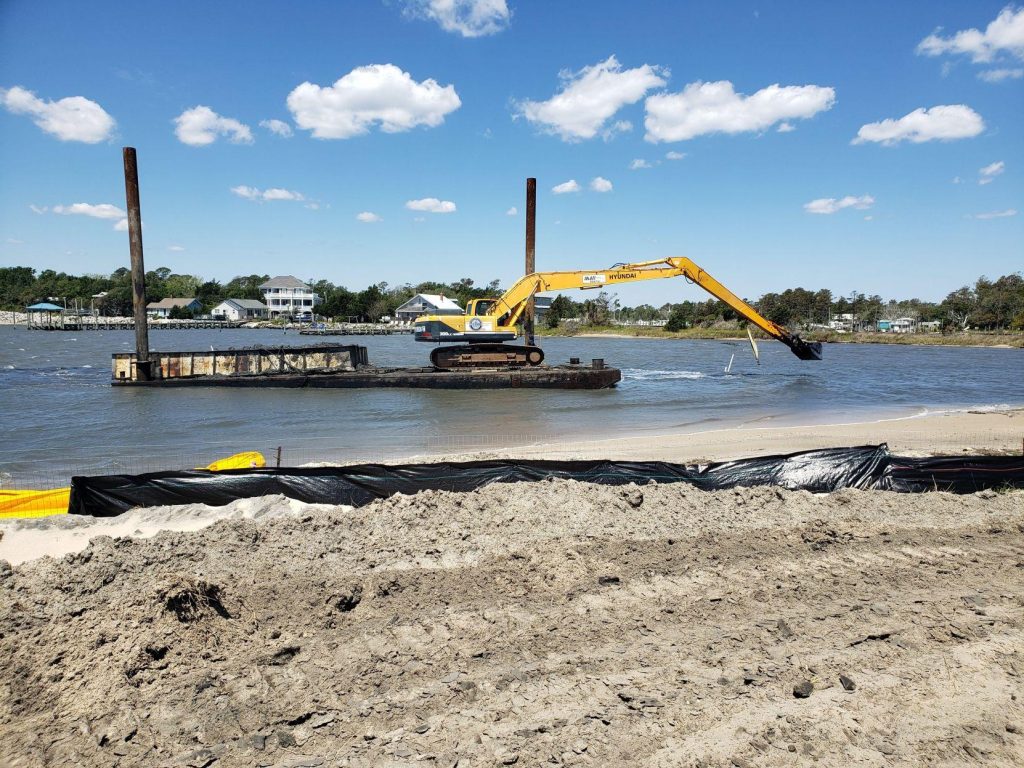
Reprinted from Carteret County News-Times
Work on the dredging portion of the Atlantic Harbor improvement project wrapped up this week, according to Carteret County Shore Protection Office Manager Greg Rudolph.
Supporter Spotlight
Despite several periods of windy, stormy weather since contractor T.D. Eure of Beaufort began work in mid-April, “everything progressed nicely,” Rudolph said.
As a result, the entire contracted amount, about 8,000 cubic yards of material, was removed before the Friday deadline imposed in the county’s state Coastal Area Management Act permit.
The project to make the harbor more accessible to commercial fishermen and other boaters will move on soon to construction of a living shoreline around White Point, in Core Sound just offshore from the harbor.
“White Point shelters most of the dredging (area) from waves that develop across the fetch of Core Sound so the weather we’ve had hasn’t really caused too many delays,” Rudolph said.
The dredging focused on a critical choke point in the area of the channel that connects the harbor to the entrance channel and the entrance channel itself, Rudolph said.
Supporter Spotlight
The county also has an option in the contract with T.D. Eure to dredge and remove an additional 5,200 cubic yards from the harbor in the fall, after the end of the period in which the state prohibits dredging.
“We’ll start making more concrete plans for that scope in the future,” Rudolph said.
The 1,720-linear-foot living shoreline will be built in conjunction with the North Carolina Coastal Federation, which promotes such projects as an environmentally friendly method to combat erosion.
The contractor will use about 9,545 tons of granite, with gaps left for fish passage and for wave attenuators, which are designed to limit wave energy into the harbor and further reduce erosion and siltation.
The federation will plant marsh vegetation, which will become habitat for oysters and other marine species. Oysters clean the water of pollutants as they feed and are a valuable seafood product. The state and the federation have pushed recovery of oyster habitat and the oyster fishery for years.
The project is intended to be as close as possible to a permanent solution to the sedimentation that has made the harbor difficult to use for the past couple of decades.
The material dredged from the waters in a bucket on a barge is being stored at White Point. When the project was in its early planning stages, there was some concern the material would be toxic and would have to be trucked away. However, Rudolph said this week, the county took seven core samples from the areas to be dredged in order to characterize the sediment texture – whether it was mostly sand or mostly mud, as well as shell content – and performed chemical analyses for pollutants. That was done even before the county requested permission to use White Point as the storage site.
“Any pollutant levels detected were very close to ambient (native to the area) levels,” Rudolph said. “We voluntarily performed the chemical analyses just to be extra sure, and to remove any uncertainty about the shoal material.”
Officials determined there was no need to haul away the material.
Rudolph said it will be contoured to meet the Coastal Area Management Act permit specifications, and once that is complete, the site will almost be ready for the granite for the living shoreline.
Before construction can begin, the county will have to remove the old sandbags along White Point and install the filter fabric on which the granite will be placed.
The project contract is for $1,949,188. Much of the money is coming from a $1.1 million grant the federation received from the National Fish and Wildlife Foundation. The state is also kicking in money, and the county’s share of the cost is expected to be about $200,000.







